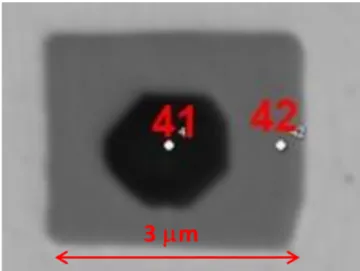HAL Id: hal-02968671
https://hal.archives-ouvertes.fr/hal-02968671
Submitted on 16 Oct 2020
HAL is a multi-disciplinary open access
archive for the deposit and dissemination of
sci-entific research documents, whether they are
pub-lished or not. The documents may come from
teaching and research institutions in France or
abroad, or from public or private research centers.
L’archive ouverte pluridisciplinaire HAL, est
destinée au dépôt et à la diffusion de documents
scientifiques de niveau recherche, publiés ou non,
émanant des établissements d’enseignement et de
recherche français ou étrangers, des laboratoires
publics ou privés.
Distributed under a Creative Commons Attribution| 4.0 International License
Inclusion cleanliness in metallic alloys
Jean-Pierre Bellot, Pascal Gardin, Frédéric Gruy
To cite this version:
Jean-Pierre Bellot, Pascal Gardin, Frédéric Gruy. Inclusion cleanliness in metallic alloys.
Metal-lurgical Research & Technology, EDP Sciences, 2019, 116 (5), pp.507. �10.1051/metal/2019026�.
�hal-02968671�
Inclusion cleanliness in the metallic alloys
Edited by Jean-Pierre Bellot, Pascal Gardin, Frédéric Gruy
E
DITORIALInclusion cleanliness in metallic alloys
Jean-Pierre Bellot1,*, Pascal Gardin2, and Frédéric Gruy3
1
Université de Lorraine, CNRS, IJL, Laboratory of Excellence DAMAS, 54000 Nancy, France
2
ArcelorMittal Global R&D Maizières, BP30320, 57283 Maizières-les-Metz Cedex, France
3
Mines Saint-Étienne, Univ Lyon, CNRS, UMR 5307 LGF, Centre SPIN, 42023 Saint-Étienne, France
Received: 9 May 2019 / Accepted: 9 May 2019
The inclusion cleanliness remains an issue of great concern in liquid metal processing which has been addressed in a full session of the last Matériaux Conference held in November 2018 in Strasbourg, France. A special issue of the Metallurgical Research & Technology journal gathers most of the papers of this session which are divided into two sub-sections: on the one hand the analysis and characterization techniques of the inclusions are addressed and on the other hand the modelling methods to simulate the behavior of single particle or a population of inclusions are discussed.
Among the recurring sources of concern of the metallur-gical industry remain the characterization and control of the inclusion cleanliness. Most of the time, in-use properties of metals and alloys are affected by isolated or clustered inclusions. Then, it is not surprising that the industry of aluminum, steel, reactive metals and super-alloys are equally concerned by the cleanliness issues. Whatever the situation, the size, the morphology and the chemical composition of the particles play a significant role. However, the requirements in terms of inclusion cleanliness are more and more difficult to achieve as the objectives of lightweighting of metallic parts, of mechani-cal performance and of cost reduction are pursued. The necessary steps to progress concerns both the detection techniques and inclusion characterization (often auto-mated), and the breakthroughs in the simulation methods of inclusion behavior in liquid metal processing. Those developments will make easier the emergence of new solutions for the control of inclusion cleanliness at the industrial scale.
The Conference Matériaux2018 held November 19–23, in Strasbourg, France, gathered around 2000 attendees. Among the large variety of topics, a workshop on Inclusion cleanliness in metallic alloys was organized. From the papers presented at this workshop, 13 were selected and reviewed for publication in the special issue of the Journal of Metallurgical Research & Technology to highlight the key scientific and engineering advances in thefield.
This special issue is divided into two complementary topics, on the one hand the analysis and characterization techniques of the inclusions are addressed and on the other hand the modelling methods to simulate
the behavior of single particle or a population of inclusions.
1 Part 1: Analysis and characterization
These techniques cover the non-destructive detection methods such as ultrasonic testing and X-ray tomography, which have made significant progress in terms of detection performance and definition, as well as all the post-mortem methods using quantitative metallography which remain nowadays often employed.
The analysis automation requires high level of statisti-cal treatments providing many internal properties of the inclusion population (composition, morphology…). The simulation of the measure is now a large area of investigation (3D prediction from 2D measurements, assessment of the measure uncertainty, theory of extreme values…) (Fig. 1).
2 Part 2: Modelling of inclusion behavior in
liquid metal processing
The numerical simulation of dispersed phases is undergoing an important scientific development that benefits simula-tion of inclusions in the metallurgical reactors. New numerical techniques are in progress today addressing complex issues at different scales (from the mesoscopic scale of the inclusion to the macroscopic scale of the process), combining both thermodynamic and fluid dynamic aspects. Moreover, the interaction between inclusions (collision, aggregation, fragmentation) and the behavior of inclusions at interfaces (solidification front, bubble, slag…) remains significant scientific challenges.
* e-mail:jean-pierre.bellot@univ-lorraine.fr
Metall. Res. Technol. 116, 507 (2019)
© J.-P. Bellot, published byEDP Sciences, 2019
https://doi.org/10.1051/metal/2019026
M
etallurgicalR
esearchT
echnology&
Available online at:
www.metallurgical-research.org
This is an Open Access article distributed under the terms of the Creative Commons Attribution License (http://creativecommons.org/licenses/by/4.0/), which permits unrestricted use, distribution, and reproduction in any medium, provided the original work is properly cited.
Finally, the thermochemical equilibrium between the inclusions and their environment (liquid metal, slag or gas) are addressed by many numerical software and databases in continuous development. All these topics
include also the behavior of inclusions after solidification, with the growth of inclusions in grain boundaries and their evolution during the thermomechanical treatments as well (Fig. 2).
Cite this article as: Jean-Pierre Bellot, Pascal Gardin, Frédéric Gruy, Inclusion cleanliness in metallic alloys, Metall. Res. Technol. 116, 507 (2019)
Fig. 1. SEM + EDS analysis of a TiN precipitate around a core of Al2O3(E. Lucas et al., MR&T, 2019).
Fig. 2. Direct Numerical Simulation of possible crossing of an inclusion pair in a pure shear flow (Courteously from M. Gisselbrecht, IJL France).
